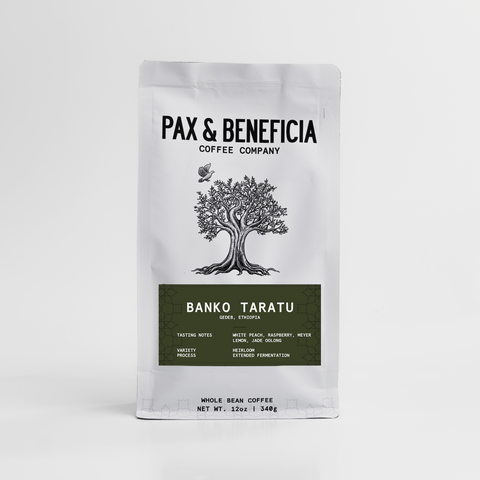
Banko Taratu - For Pour Over, Drip, & Espresso
Roaster Notes:
This is the perfect coffee for summertime! Floral notes dance off of the dry grinds just begging to be brewed. Water really brings out the clean Jasmine sweetness, and the first sip does not disappoint. Delicate White Peach meets your palette atop notes of a pear and panela-esque body with a beautifully round and cashmere mouthfeel. The raspberry lemonade acidity really comes out to play as the cup cools and offers a final floral, jade-Oolong-like kiss to linger on your tongue. This gorgeous cup is complex and vibrant, perfect iced or hot. Welcome to our new summertime pour over!
Importer Notes:
“Gedeb Banko Taratu, is in the southern part of Ethiopia Yirgacheffe, Gedeb District within the Gedio zone and is one of the highest elevated coffee-growing areas in Ethiopia with a pick altitude of 1900- 2300 meters above sea level where this coffee is grown and prepared. The annual rainfall is between 1200mm-1599mm. The harvest period is between October -January. The variety of this coffee is Indigenous heirloom. The coffee is named after the town itself. In Banko Taratu coffee is grown near the farmers' homes Garden and is mainly grown on a small plot of land, coffee is grown from large trees near homes. The coffee has a low overlap of 1000-1800 trees per hectare. It is grown with natural fertilizers. Coffee is one of the very important things for the Banko Taratu community and it’s a home for many coffee farmers’ families producing, also these areas are some of the most popular and well-known growing regions in the coffee world. They also grow false bananas on the coffee farm to feed themselves and their families. We receive coffee cherries to our processing sites from over 300 family-owned farmlands in Banko Taratu. Handpicking is the only method of coffee processing throughout the harvest time, and it is done by farmers and their respective family members. After conducting the harvesting stage, the washing process is carried out using a washing machine (pulp machine) that uses water to physically brush the skin of fresh cherries. The coffee beans are next steeped in fresh spring water for 24 to 48 hours, depending on the weather conditions, for wet fermentation to eliminate any remnants of sugar coating around the cherries (mucilage). The parchment is carefully channel washed when fermentation is complete. The coffee is next shade-dried for a few days until it reaches 30 percent moisture content, then sun-dried to 11 percent moisture content on raised African beds. In this technique, the coffee is dried for two weeks, then the well-dried coffee will be transported to Addis Ababa (capital city of Ethiopia) to conduct the next stages where the coffee gets milled and exported from Ethiopia.”
TASTING NOTESWhite Peach, Raspberry, Meyer Lemon, Jade Oolong
ORIGINGedeb, Ethiopia
VARIETYHeirloom
PROCESSExtended Fermentation